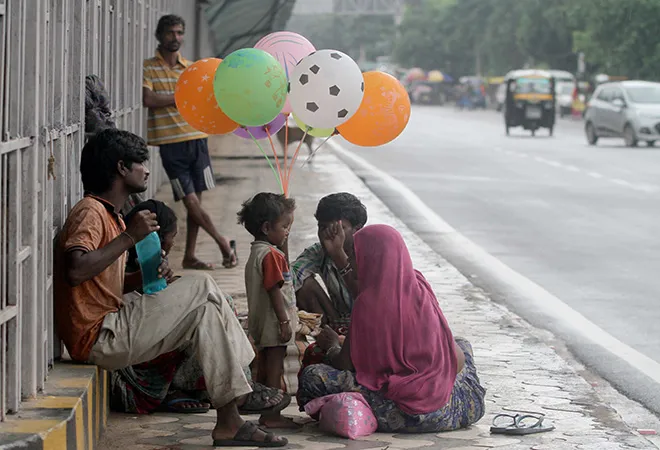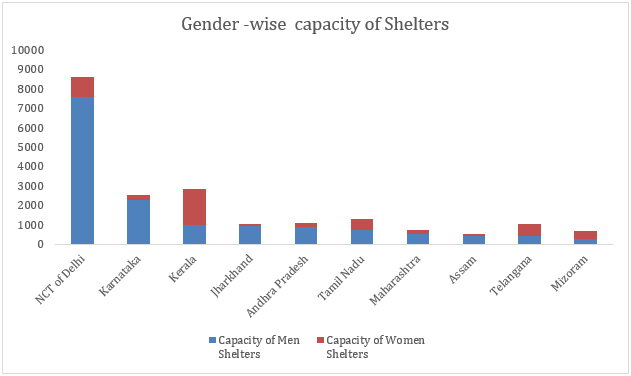
In India, the northern states face extreme weather in peak winter and summer. Hundreds of homeless people die in winter due to
harsh cold conditions and, in summer,
due to intolerable heat. There is an absence of official records enumerating deaths due to homelessness. It undermines the scale of the crisis in the era of statistics and showcases states apathy.
Homelessness is one of the worst forms of marginalisation as most homeless individuals suffer from malnutrition and extreme poverty. Access to healthcare facilities and their affordability is also a hurdle. Exorbitant conditions affect mental health in many cases. Moreover, these conditions also give rise to drug and alcohol consumption. It creates a conducive situation for substance abuse. Such circumstances increase an
individual’s vulnerability to violence, especially in the case of women and children. Stigmatisation and social marginalisation compound their precarious situation. In a nutshell, homelessness strips a person from all human rights.
Drivers of homelessness
Extreme poverty, inadequate affordable housing, high levels of inequality, and discrimination are primary drivers of homelessness. In urban areas, low wages, high rents, and the soaring cost of living force many to choose between either food or shelter. The lack of employment opportunities pushes many individuals to migrate to cities , out of which many resort to living on the streets.
Homelessness is one of the worst forms of marginalisation as most homeless individuals suffer from malnutrition and extreme poverty.
Family disputes, domestic and substance abuse, and physical and mental violence force many to flee from their families.
Rights of homeless individuals
Article 21 of the Indian Constitution deals with the fundamental right to life and personal liberty. The Supreme Court has held
that the right to dignified shelter is part of the right to life. It entrusts the responsibility of providing housing to the state. It is possible to avoid such deprivation due to homelessness if people have access to a shelter. It highlights the state's failure to provide its citizens with an adequate social security net.
The Government of India envisaged housing for all by 2022. It has devised policies and sub-schemes under Pradhan Mantri Awas Yojana. The government's goal of providing housing for all will not be achieved until it covers the homeless population.
Shelter for Urban Homeless (SUH)
As the name suggests, the scheme seeks to provide shelter to the urban poor. SUH is a sub-scheme under Deendayal Antyodaya Yojana-National Urban Livelihoods Mission (DAY-NULM). The scheme guidelines mention the following provisions:
- All weather permanent shelters will be open for 24 hours.
- Permanent community centre for at least 100 people for every 1 lakh population.
- Each one should cater to 50-100 persons depending on local conditions.
SUH Scheme Progress*
| No. of Shelters |
Capacity of shelters |
Constitution of Shelter Management Committee |
Training to Shelter Management agency |
Installation of CCTV Camera |
| 2462 |
124498 |
1417
(57.5%) |
1096
(44.5%) |
1371
(55.6%) |
Source: Deendayal Antyodaya Yojana-National Urban Livelihoods Mission (DAY-NULM), Ministry of Housing and Urban Affairs- - September 2022
*Includes NULM and Non-NULM Shelters
The scale of the problem
The
2011 census estimates that nearly 17.7 lakhs people as houseless, however, the census fails to capture the entire homeless population. Furthermore, since census are conducted in every 10 years, this data is decadal old. As per the Commissioners of the Supreme Court,
1 percent of the urban population is homeless, making it a population of ~37 lakhs. The Ministry of Housing and Urban Affairs conducted
a third-party survey in 2019 to identify the urban homeless. It estimates that approximately 23.93 lakh people are homeless. Population increase and the COVID-19 pandemic have fueled the rise in the homeless population. The five states with the highest number of homeless populations are as below:
| Sr No |
State/UT |
Number of Urban Homeless |
| 1 |
Rajasthan |
39,512 |
| 2 |
Gujarat |
35,293 |
| 3 |
Uttar Pradesh |
28,409 |
| 4 |
Maharashtra |
21,882 |
| 5 |
Haryana |
19,015 |
Source: Ministry of Housing and Urban Affairs
However, the current capacity of shelter homes under the
urban homeless scheme caters only to 1.2 lakh people—a drop in the ocean when compared to the requirement. Further, a gender-wise capacity analysis showcases that capacity of women's shelters is abysmal when compared to male counterparts. It's an arduous task for a homeless woman to get access to shelter.
 Top 10 states with the highest capacity. Source- Deendayal Antyodaya Yojana-National Urban Livelihoods Mission (DAY-NULM), Ministry of Housing and Urban Affairs- - September 2022
Top 10 states with the highest capacity. Source- Deendayal Antyodaya Yojana-National Urban Livelihoods Mission (DAY-NULM), Ministry of Housing and Urban Affairs- - September 2022
The Supreme Court panel in 2017 found that
the state governments did not use 50 percent of funds for the homeless scheme. Non-utilisation of state funds is still a significant hurdle in scheme implementation. After this , all states and UTs have constituted a State-level Monitoring Committee. The Union government should ensure that the State government are empowered to avail all the funds.
Hurdles in accessing the shelters
Despite the public provision of shelters, many homeless people face a several hurdles in accessing them. These include:
- Most of the homeless are in the informal economy, lacking necessary documentation like voter ids, Aadhar card, etc. It makes them ‘invisible’ in the eyes of the city administration, and their voice remains unheard. For example, a 2019 survey conducted by Municipal Corporation Chandigarh found that 49 percent of homeless lack any identification proof. They are usually categorised as nuisances to city life. The current scheme guidelines do not address the issue of exclusion. Therefore, it is crucial to ensure inclusivity. Recognising the rights of homeless people over the city is the first step toward addressing the problem of homelessness.
- Homeless people face entry-level barriers in accessing public shelters due to local issues such as shelter location, entry fees, and identification proof for verification. Access to food, health, education, and livelihood remains to be a distant dream for most homeless people.
- The responsibility of accessing the homeless population rests with the urban local bodies. Local authorities need to conduct surveys to assess the homeless population. The current status of the city-wise study needs to be present. The need of the hour is to ensure visibility on city-wise survey progress and ensure it is implemented across all the cities.
Present conditions of shelters
According to the scheme guidelines, the following aspects are required at a shelter:
- Water arrangement
- Cooking space and childcare facility
- Proper lighting and ventilation
- Bathing and toilet facility
- Recreational space
- Fire protection apparatus
- Pest and vector control measures
- Bedding material
- First-aid kits
- Opportunity for convergence with other government schemes
All the above factors are designed considering the peculiar needs of homeless individuals.
A 2018 study of shelter homes in Uttar Pradesh found that mental health counselling, referral system cooking and childcare facilities are crucial for the people living in shelters. However, these facilities are not generally available. It also showcases the poor quality of the facilities provided at the shelter. A similar kind of study in
2017 raised quality concerns and highlighted that only a few shelters have a facility of convergence with other schemes. The quality of service delivered in shelters is one of the ignored aspects that needs urgent attention.
A 2018 study of shelter homes in Uttar Pradesh found that mental health counselling, referral system cooking and childcare facilities are crucial for the people living in shelters.
The Shelter Management Committee (SMC) manages the shelters at the city level. The committee is crucial to ensure local-level problem identification and resolution. However, only 57.5 percent of shelters are under the purview of SMC. Moreover, 55.5 percent of the SMC members have yet to undergo training.
Empowerment of ULBs
The above conditions also highlight the more significant issue of implementing the 74
th Constitutional Amendment Act that helped decentralise governance. It was the state government’s responsibility to devolve power to local bodies. However, in most cases, urban local bodies (ULBs) are appendages of state governments. Parastatal bodies such as the housing boards carry out core municipal functions. ULBs are dependent on state governments for funds, functions, and functionaries, thus causing a fall in the capacity of ULBs to perform their core functions, including the maintenance of the public shelters.
State governments must implement the 74
th Constitutional Amendment in its true spirit. Its implementation will empower ULBs, which can then bring all the shelter homes under the ambit of SMCs and train them to manage local issues. Strengthening ULBs and SMCs is crucial as they can aid homeless people in preparation and accessing basic needs, including identifications proof. It can help them to secure benefits and guarantee the convergence of various government schemes, thus also addressing deep-rooted issues like violence and exclusion.
ULBs are dependent on state governments for funds, functions, and functionaries, thus causing a fall in the capacity of ULBs to perform their core functions, including the maintenance of the public shelters.
Conclusion
The aim of providing housing for all will remain a distant dream if the homeless are not covered. Sheltering the homeless is a crucial link in the overall housing continuum. The state governments need to empower municipal bodies to ensure the decentralisation of governance. It is vital for ULBs, state, and central governments to work in tandem and priority to address the needs of the most vulnerable section. The homeless population faces a multidimensional deprivation state that can address through various crucial recovery support services. Revamping quality measures and increasing shelters’ capacity under the SUH scheme is the need of the hour.
The views expressed above belong to the author(s). ORF research and analyses now available on Telegram! Click here to access our curated content — blogs, longforms and interviews.



 In India, the northern states face extreme weather in peak winter and summer. Hundreds of homeless people die in winter due to
In India, the northern states face extreme weather in peak winter and summer. Hundreds of homeless people die in winter due to 
 PREV
PREV


